
Utilizing a disaggregated model and using a three-stage least squares process. This paper estimates the Demand for Automobiles in the world by size class. Although there was a significant price-elasticity difference between the demand for each market. Was considerably higher than the other. Variables such as the price of gasoline as well as styling. And the changing demographics affected each market in a different way. In this Blog, we will talk about Sensors and Scanners in automobiles which will be beneficial for you.
How sensor technology will shape the Automobiles
Sensors are now an essential element of modern car design, serving a myriad of reasons. They aid manufacturers of cars to bring models. On the market that are safer, more efficient on fuel, and safer to ride. In the future sensors will also facilitate more automation of vehicles and the automotive industry will gain from it.
Intelligent observation
Alongside full controllability and information processing intelligence is an essential element for cars to make decisions independently. To achieve full observability, cars must be able to process a variety of parametric data . Including speed and current, pressure temperatures, temperature, position and gesture recognition, proximity detection as well as others. Concerning the detection of proximity and recognition for gestures. Significant advances have been made in the past few years, thanks to ultrasonic sensors. As well as timing-of-flight (ToF) camera systems currently being installed in vehicles.
Ultrasonic sensor
As vehicles become more automated it is not just witnessing new technologies being applied to the automotive industry. In the very first instance however. We are seeing the transformation of existing automotive technology to the specific requirements autonomous driving will require. At present ultrasonic sensors are commonly fitted into the bumpers of vehicles for assistive parking.
As of now, these sensors can only work at speeds of less than 10km/hour and aren’t able to determine distances. Of a small amount with 100 percent precision. In an autonomous vehicle, however, these sensors could be utilized together with radars cameras. Cameras, and other sensing technologies to provide distance-measurement capabilities.
Gesture recognition
While ultrasonic sensor technology can be used to look out into the globe. ToF cameras are focused on the inside of the car. As the transition from manual to autonomous driving is an incremental process. And not a quick one, it is crucial that drivers are able. To change from autonomous mode to manual mode only in certain situations.
The current state of cars is partially autonomous through the using their Advanced Driver Assistance Systems (ADAS) mechanisms, however, human involvement could become necessary at any time. We anticipate that the field will progress towards higher levels of automation over the next few years, however, even then the driver will need to be able take the reins in certain conditions (e.g. when the vehicle is within city centers). It will take a long period of time before the occurs.
At some point, vehicles must be able to warn its driver. So, monitoring real-time the driver’s location and movements is vital. Although it is still in its infancy phase, ToF technology is already being used today for various reasons, including making drivers aware that they have suffered an inattention lapse and cause their vehicle to drift towards the side or road. It also permits various tasks to be executed by relying on gesture recognition, such as gestures that increase the volume of the radio or to take an incoming call.
The scope of ToF extends far beyond this kind of task but it could be a key component in more sophisticated automated driver systems when it is built. Cameras with ToF will have the ability to track a driver’s entire upper body in 3D, meaning that it is possible to determine whether the driver’s head is in front of the road ahead and if their hands are positioned on the steering wheel.
Click Here also for Three dimensional Images.
What does a Scan Report Tell You?
Diagnostic scans are performed via connecting the automobile’s info portal, also known in the form of the Diagnostic Link Connection (DLC) or OBDII typically located under the dash of the driver’s side but some vehicles may have DLC inside the engine compartment. The scanner can be used to gain access to and interpret information inside the vehicle. The diagnostic software within the scanner checks the vehicles systems to identify faults and Diagnostic Trouble Codes (DTCs) and will also examine systems even when the vehicle is in operation to verify the operation.
The vehicles are built with a variety of microchips, processors for computers sensors and modules that regulate various electronic systems inside the vehicle. Mechanical mechanics have relied upon scanning devices for diagnostics for over 20 years to complete various elements of mechanical repair. In the past, professionals in collision repair were less dependent on scanning equipment to carry out repairs.
The advancements in technology for automobiles such as sophisticated driver-assist systems as well as advanced comfort features have dramatically altered the method by which collision repair shops determine the severity of damage to the diagnostic and electrical systems of the vehicle.
When a damaged car is brought to an auto body repair shop, among the initial tasks that the technician or estimator should investigate is the OEM repair procedure for the specific type of vehicle and determine the build information, as well as the point of impact and the severity extent of the damage to the vehicle. Diagnostic scans may be the only way to evaluate the importance of this type of repair data.
SCANS AND THEIR BENEFITS
Scanning should be included in a Standard Operating Procedure (SOP) at the time of an initial check of the car. The procedure is commonly referred to as Triage also known as Blueprinting. Scanning can easily detect electronic system malfunctions and non-operational components. A lot of DTCs won’t cause or show the Malfunction Indicator Lamp (MIL) that is displayed on an instrument panel. For this reason, the vehicle needs to be scan.
In the event of deployed airbags that have been repaired the SRS indicator lamp is not going to be able to go out. Airbags are typically replaced at the conclusion of the repair process, and typically just prior to the delivery. If an SRS component is damaged, occurs near the end of repairs to the vehicle, it may cause an unnecessary delay in the delivery of the vehicle, which typically results in an additional.
This is something that no one wants or needs should it be avoided. Pre-scanning by using an asTech(tm) asTech(tm) device can stop almost all of these expensive repairs that take a long time. Some of the systems you can scan or pre-inspect are listed below:
Diagnostic Information
- Engine operation
- Fuel management
- Transmission
- Emissions Control
- Stability Control System
- Antilock Brake System
- Airbag System
- Lane Departure
- Tire Pressure Monitors
- Camera Systems
- Parking Aid Systems







